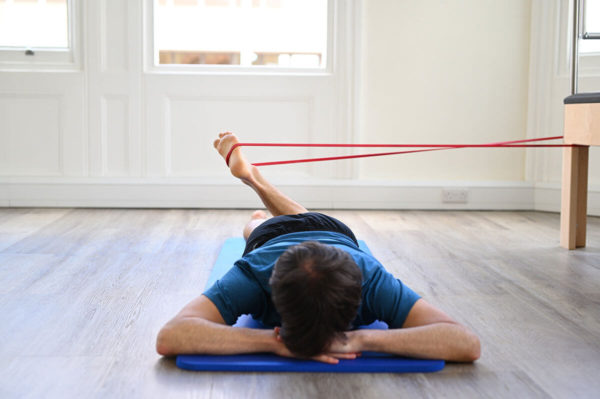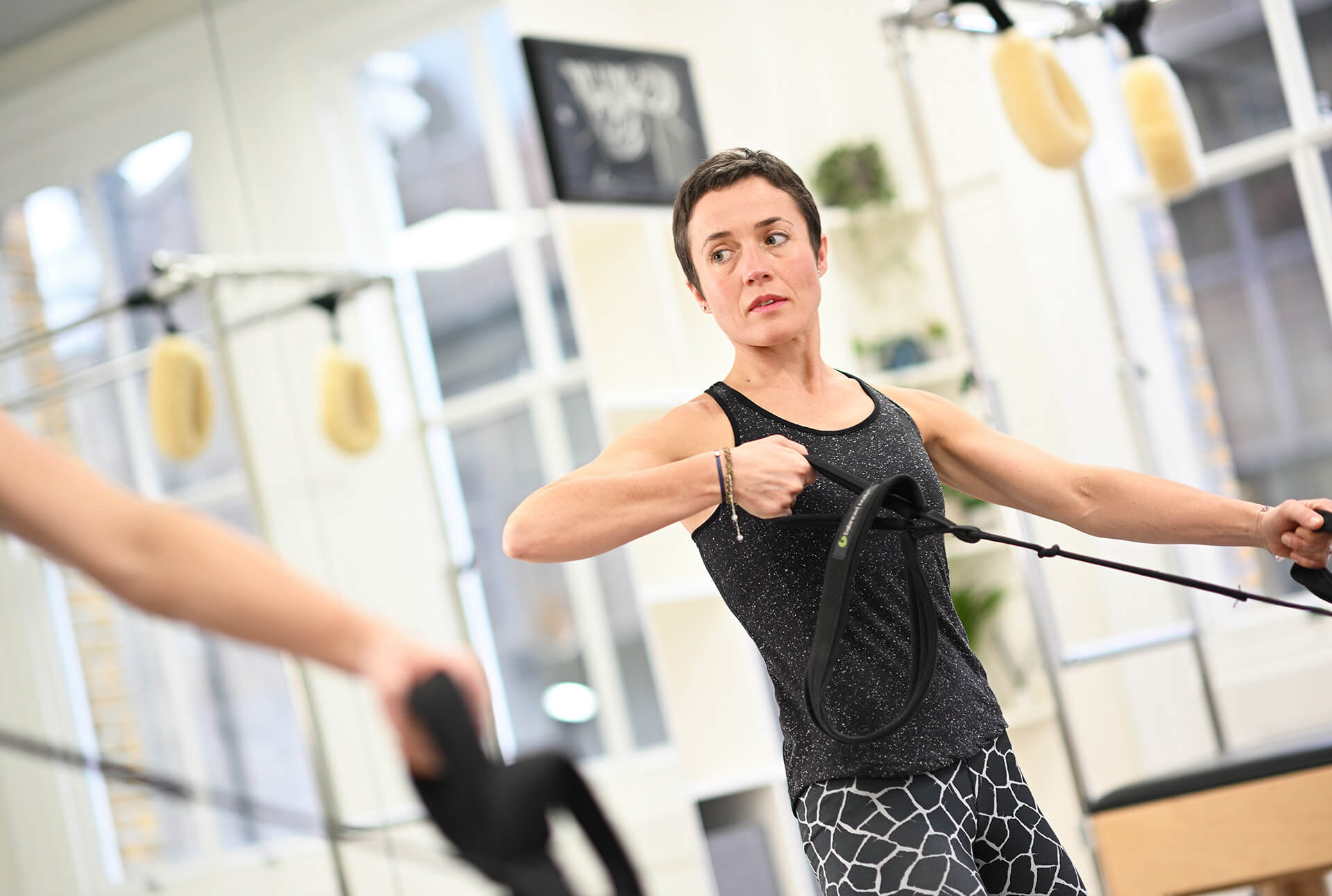In this article, we’ll be discussing the benefits of resistance bands and why they should be incorporated into your daily workout routine.
Not only are resistance bands highly versatile, portable pieces of equipment, they can add a whole level of difficulty to your workouts.
Whether you find yourself traveling frequently, find it difficult to get to the gym or only have a spare half an hour here or there, resistance bands can be the perfect solution to getting a workout in at anytime from anywhere.
If your goal is to build, strength, or recover from an injury, the uses and benefits of resistance bands are endless.
Below, we’ll explain what resistance bands are, the benefits and how to use them.
What are resistance bands?
Resistance bands, or exercise bands, are known as elasticated bands which typically come in a variety of lengths, tensions and widths. Some resistance bands are designed to be straight, flat or in loops whilst others are tubular with handles.
Generally speaking, the thicker the resistance band the greater the resistance it provides, meaning greater difficulty. Conversely, the thinner the resistance band the less the resistance it provides, meaning less difficulty. This is also often shown in colours with black typically being the heaviest and yellow being the lightest.
They are an easy-to-use piece of equipment which are highly versatile and portable. For example, resistance bands can be used for all manner of reasons including to build muscle, increase strength, aid rehabilitation or provide support whilst doing other exercises such as assisted pull ups.
The most common types of resistance bands include:
- Pull-up/Power Resistance Bands (Loop Bands): These are probably the most common form of resistance bands. They are flat looped bands that can be used for a variety of purposes whether that be to assist your body weight (when doing pull ups, dips etc.), to act as a bodyweight resistance, as a full body workout and in rehabilitation exercises.
- Tube Resistance bands with handles: As the product name suggests, these resistance bands have handles to mimic a gym machine that can be anchored to a door, bar or pole. These resistance bands are particularly good for exercises which involve pressing or pulling.
- Rubber/Fabric Mini/Flat Resistance Bands: Similar to power resistance bands, mini resistance bands are designed to be shorter and wider to increase strength and stability in predominantly lower body exercises. These bands are typically used above your knee or around your ankles to activate your glutes, hips and core and improve form. We also use them around your wrists to aid in rotator cuff strength of the shoulders.
- Therapy Resistance Bands: These are generally what physios use and come in a variety of thicknesses so that you can gradually increase weight in exercises. They generally do not loop (unless tied in a knot to create a loop). A therapy resistance band is particularly useful for people recovering from an injury or for those looking for a low impact workout alternative. Light therapy bands can be used for dynamic and static stretching to improve mobility and range of motion (ROM).
- Figure 8 Bands: The resistance bands resemble a figure of 8 with handles at either end. They can be used for both upper and lower body workouts particularly pushing and pulling exercises which are designed to aid rehabilitation, muscle strengthening and endurance.

Benefits of resistance bands
Whilst resistance bands come in all shapes, lengths, widths, and strengths there are numerous resistance band benefits that could take your training or rehabilitation to the next level.
1. Support and aid rehabilitation
Resistance bands, namely, light therapy resistance bands, are commonly used for rehabilitation and stretching exercises.
If you have or are currently suffering from an injury, particularly shoulder, hip and knee injuries, resistance bands can be used as a warm-up to help activate specific muscle groups, as a cool down, or to increase the intensity of a workout as you build strength.
Because resistance bands do not load the spine or joints with excessive weight (unlike heavyweights) you can benefit from a manageable and supportive level of resistance to help strengthen specific muscles groups such as, but not limited to, the glutes, calves, shoulders, back and biceps.
2. Versatile and adaptable
Resistance bands are highly versatile. With a variety of different resistance bands to choose from, also comes a variety of different exercises which can be performed.
Depending on the type of resistance band, you can perform glute, quad, calf, shoulders and arm exercises at differing levels of intensities.
This means you can focus on one or multiple muscle groups with a resistance band but also increase the strength of the band as you progress through your training.
If you do not want to buy lots of different kinds you can also simply hold the band tighter, this will give you more resistance! When buying them online, they also normally come in a pack which has different weights. This means you have the progression already there!
3. Portable
Resistance bands are small, portable pieces of equipment that can be taken anywhere. They are also lightweight in nature so can easily be taken on the go with you unlike hand weights or machines which restricts you to a fixed location.
Resistance bands are particularly beneficial for people who travel frequently, commute to and from work, do not have access to a gym or are time limited.

4. Build strength and endurance
People often underestimate the strength of resistance bands as they look small and unassuming, however, with the different levels of intensities, you can make your workouts as easy or difficult as you like.
Resistance bands allow you to build strength progressively by gradually increasing the resistance of the band without having to use weights.
For example, if your focus is building strength, you may do fewer repetitions at a higher resistance. On the other hand, for developing endurance, you may do more repetitions at a lower resistance. We know that they are not as effective as weights but for a multitude of reasons are more accessible so a great place to start!
5. Increase flexibility & mobility
Resistance bands are often used for stretching when your objective is to improve your flexibility and mobility.
Resistance bands allow you to deepen your stretch and increase your flexibility by adding a level of pressure or tension.
It is important to deepen your stretch using the additional tension created by the resistance band but not to push through any pain you may be experiencing on your muscles which could lead to injury.
6. Improve stability
If you are new to using resistance bands, you may feel unsteady when using them at first. However, this will ensure you work harder to recruit and target your stabilising muscles and core to maintain form and balance.
It is also important to control the tension and release of each movement when using resistance bands to ensure you are getting the most out of your workouts. Again, this helps you to control the execution of the movement and target your stabilising muscles to maintain control throughout.

7. Aid compound exercises
Resistance bands are designed to aid compound exercises which involve using several muscles at any one time.
If you are looking to do a full body workout, but do not have access to weights, with just one piece of equipment, resistance bands are definitely a solution.
For example, a resistance band can be used to increase the intensity of a squat which works the quadriceps, glutes and the calves.
8. Improved technique and form
More often than not, we can all be guilty of using momentum to complete reps when using free weights.
However, when using resistance bands this is much more difficult to do as you’re required to maintain tension on the bands throughout the workout. This means your muscles should be working from start to finish, not just on the execution of the rep.
9. Supports progression
As previously touched upon, resistance bands come in a variety of resistance levels which means you can aid your progression by adding resistance or adding assistance to your workouts at any point.
For example, if you cannot yet perform a pull-up independently, a resistance band can provide assistance and support to pull your bodyweight up much easier than you would otherwise be able to. When you have increased your strength and endurance, you can look to remove the resistance band and try pulls-up unassisted.
Related reading: Pilates band exercises
Summary of Benefits of Resistance Bands
At Complete Pilates, we specialise in clinical, physio-led Pilates classes to help women and men achieve their goals.
If you are new to using resistance bands we can provide advice and guidance to ensure you execute exercises properly and safely. Alternatively, if you are looking to improve your flexibility, posture, strength and stability, we can look to find a suitable 1 to 1 or group Pilates class which aims to support your goals.
We have a range of classes to choose from including:
- Pilates for beginners
- Pregnancy Pilates
- Postnatal Pilates
- Physio Pilates
- Online Pilates
- Group Pilates
For more information, please get in touch! online or contact us on 0203 764 5668.
These blogs are designed to give information to everyone, however, it is important to remember that everyone is different! If you have not seen one of our therapists and have any questions about injuries, what you have read or whether this may be useful to you, please just ask. We are more than happy to help anyone and point you in the right direction. Our biggest belief is that education is key. The more you understand about your injury, illness and movement, the more you are likely to improve.




